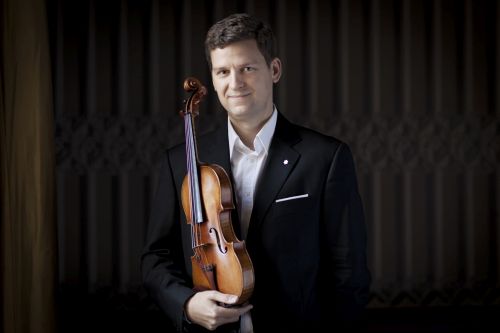 United States Tilson Thomas, Beethoven, Bartók: James Ehnes (violin), London Symphony Orchestra / Daniel Harding (conductor). Granada Theatre, Santa Barbara, California, 13.7.2019. (LV)
United States Tilson Thomas, Beethoven, Bartók: James Ehnes (violin), London Symphony Orchestra / Daniel Harding (conductor). Granada Theatre, Santa Barbara, California, 13.7.2019. (LV)

Michael Tilson Thomas – Agnegram
Beethoven – Violin Concerto Op.61
Bartók – Concerto for Orchestra Sz.116
With an enthusiastic Daniel Harding on the podium, filling in for Michael Tilson Thomas taking the summer off for repairs, the London Symphony Orchestra began its concert with a tribute: Tilson Thomas’s Agnegram, written in 1998 to celebrate the 90th birthday of San Francisco Symphony patron Agnes Albert as ‘a portrait of her sophisticated and indefatigably enthusiastic spirit’. The massive ensemble, crammed onto the Granada Theatre stage, stunned the sold-out house with the conductor’s highly entertaining seven-minute-long overture. Laced with affection and secret jokes, bouts of Spike Jones percussion, circus music, and biblical Hollywood with undertones of Broadway shows, it only lacked memorable tunes. Nevertheless, the piece must have delighted the symphony’s community — not to mention, the honoree — and in the program notes, the composer’s detailed description of the themes made for a good read.
With James Ehnes as the soloist, Beethoven’s Violin Concerto was very special. The initial four timpani strokes faded away almost to inaudibility, the woodwinds sang generously, and the crunch of the cellos and basses signaled their presence. As Harding’s moderate, flowing speed for the opening introduction laid out the vast expanse of orchestral tuttis, Ehnes emerged as if he had been playing along all the time. From then on his impeccable, flexible line was in charge, with the full cooperation of Harding and the orchestra — including its wonderful bassoonists, always key to a successful reading of the concerto.
Ehnes was magnificent throughout, an impassive figure on stage whose playing blazed like a laser beam, though brimming with compassion and heart. He judged the upward triplets towards the first movement’s peak climax so precisely that the end of his crescendo coincided perfectly with the end of the mounting orchestral excitement. Using the Kreisler cadenza, Ehnes was spontaneous to the point of almost forgetting it wasn’t by Beethoven, which is its only known complaint.
The Larghetto was exquisite, with the orchestra in gorgeous form, and Ehnes’s little passage against the strings’ pizzicatos was heavenly, floating along. But then he supercharged the cadenza with 20 seconds of pyrotechnical flourishes leading to an Olympian Allegro. As his encore, Ehnes played Ysaÿe’s third Sonata from the Op.27 set, a mark of his seriousness of purpose — and courage.
After intermission Bartók’s Concerto for Orchestra started off with an Introduzione that could have been a misterioso, and the Granada Theatre space now seemed to be three-dimensional, as the spotlight shifted among instruments and instrument groups. The LSO ported its elegant, dynamic style to Bartók’s entirely different soundscape with crisp energy and physical beauty: eloquent flute, silken violins, a liquid oboe solo, and all in audiophile clarity, texture, and dynamic range. Speeds throughout felt slightly faster than they were; when the end arrived, the audience acknowledged with such thunderous applause that Harding led a lingering version of The Flying Theme from E.T. as an encore. The mere announcement of it had the audience cheering and sighing with delight.
Laurence Vittes